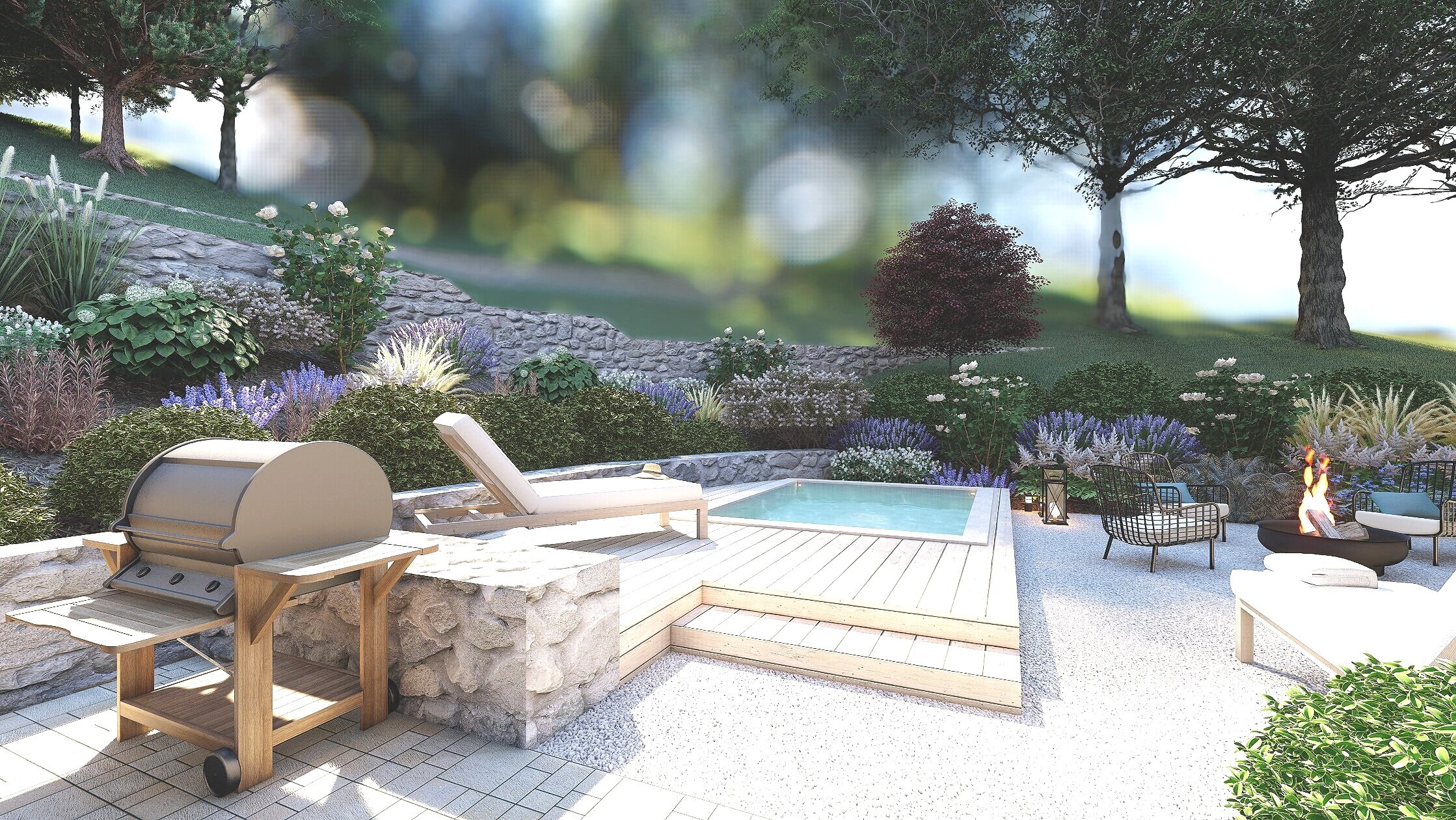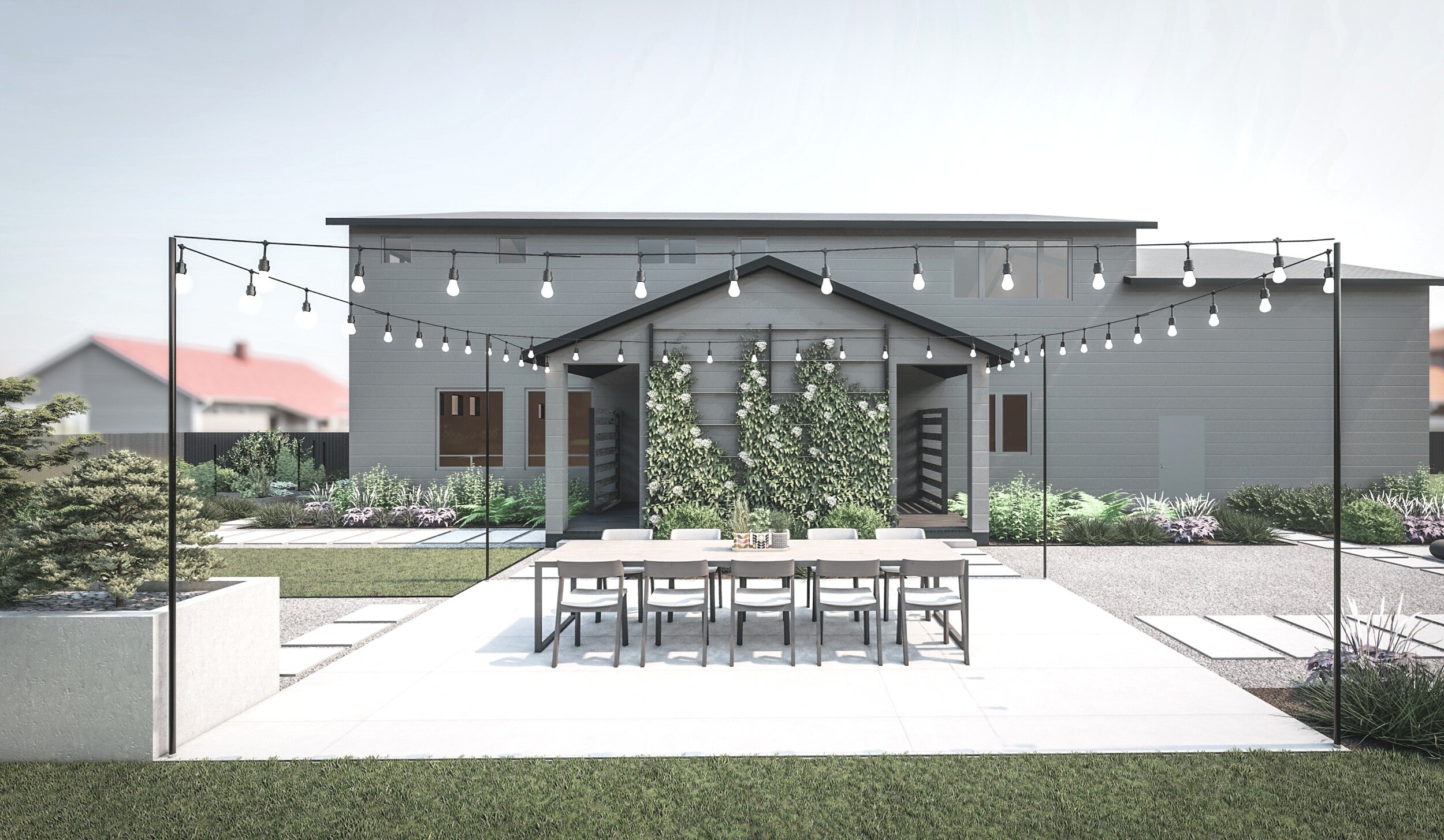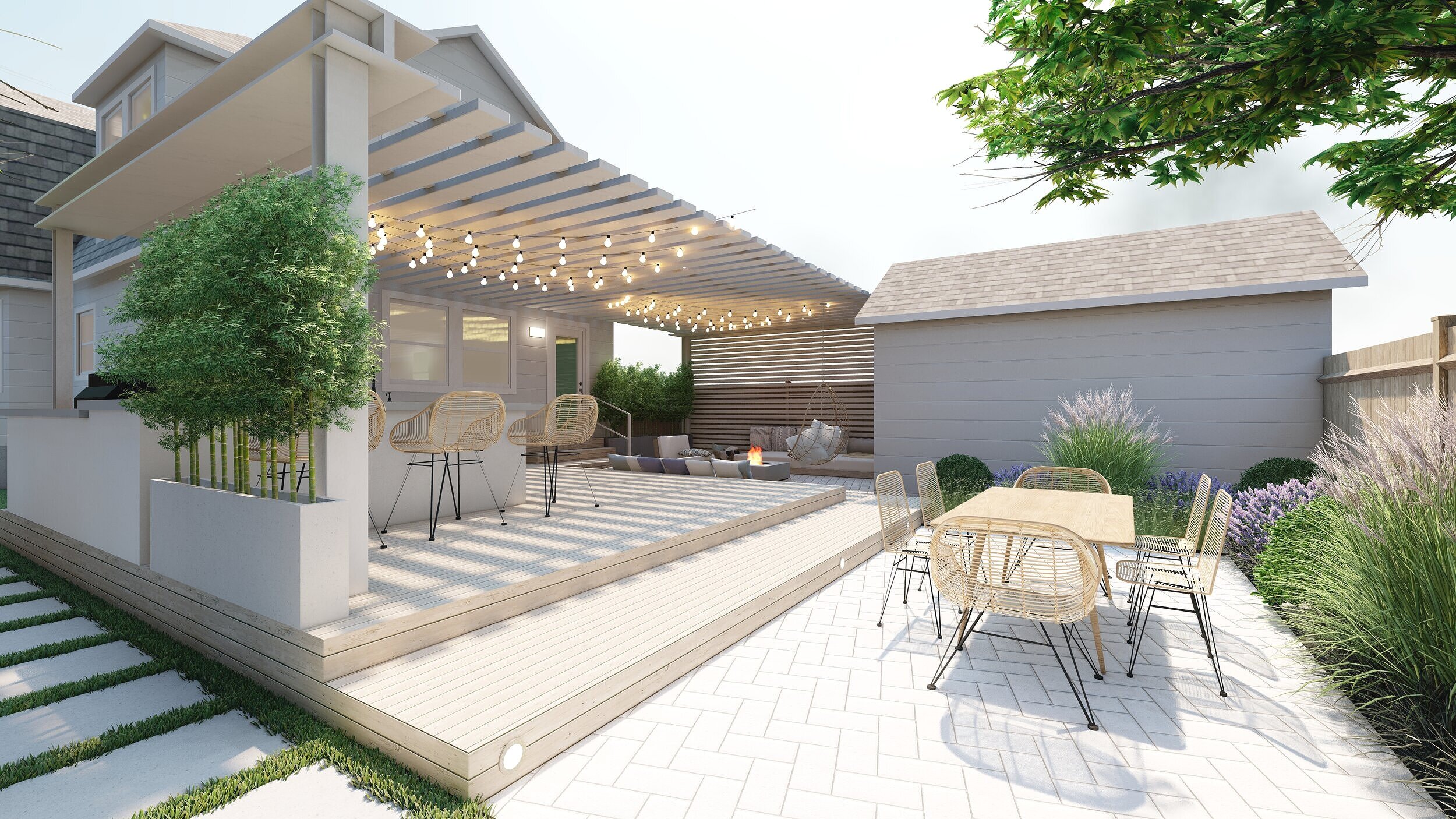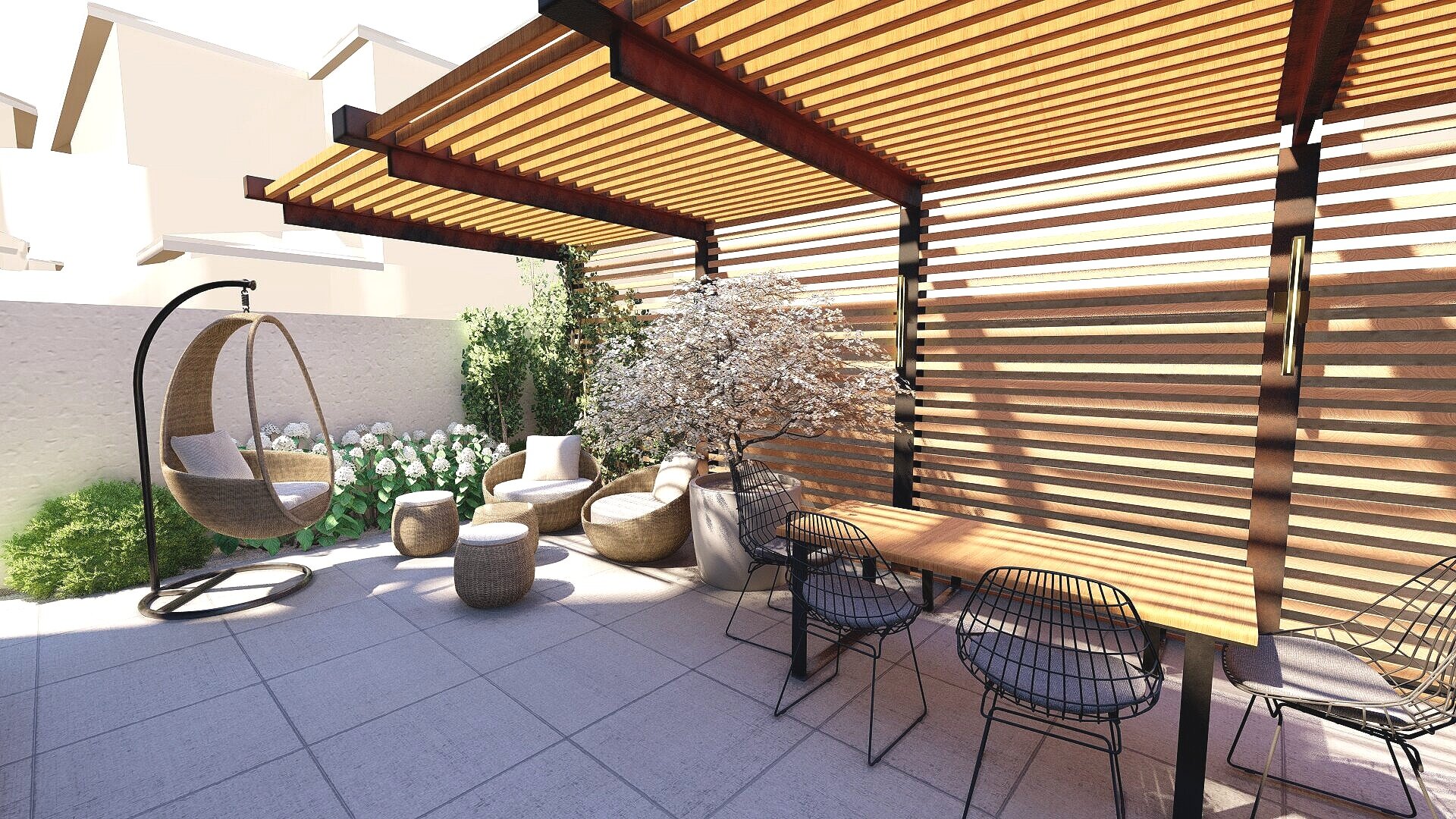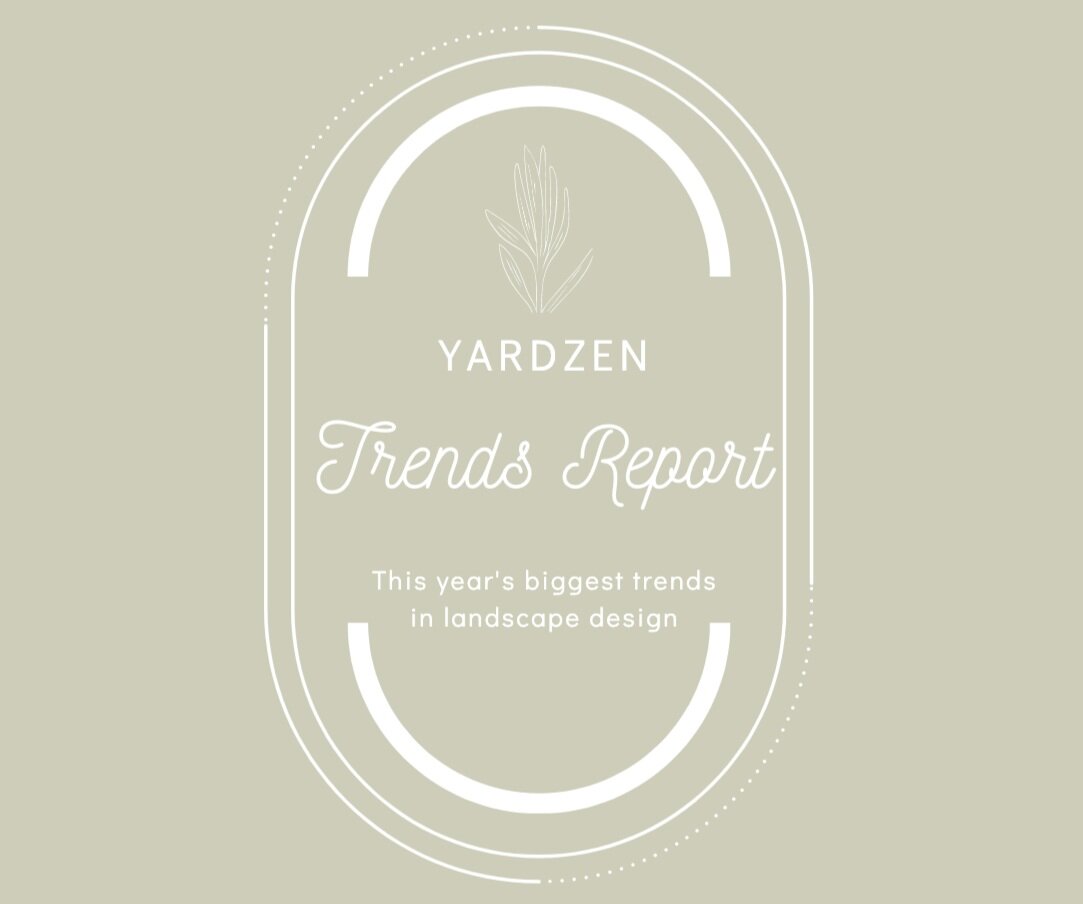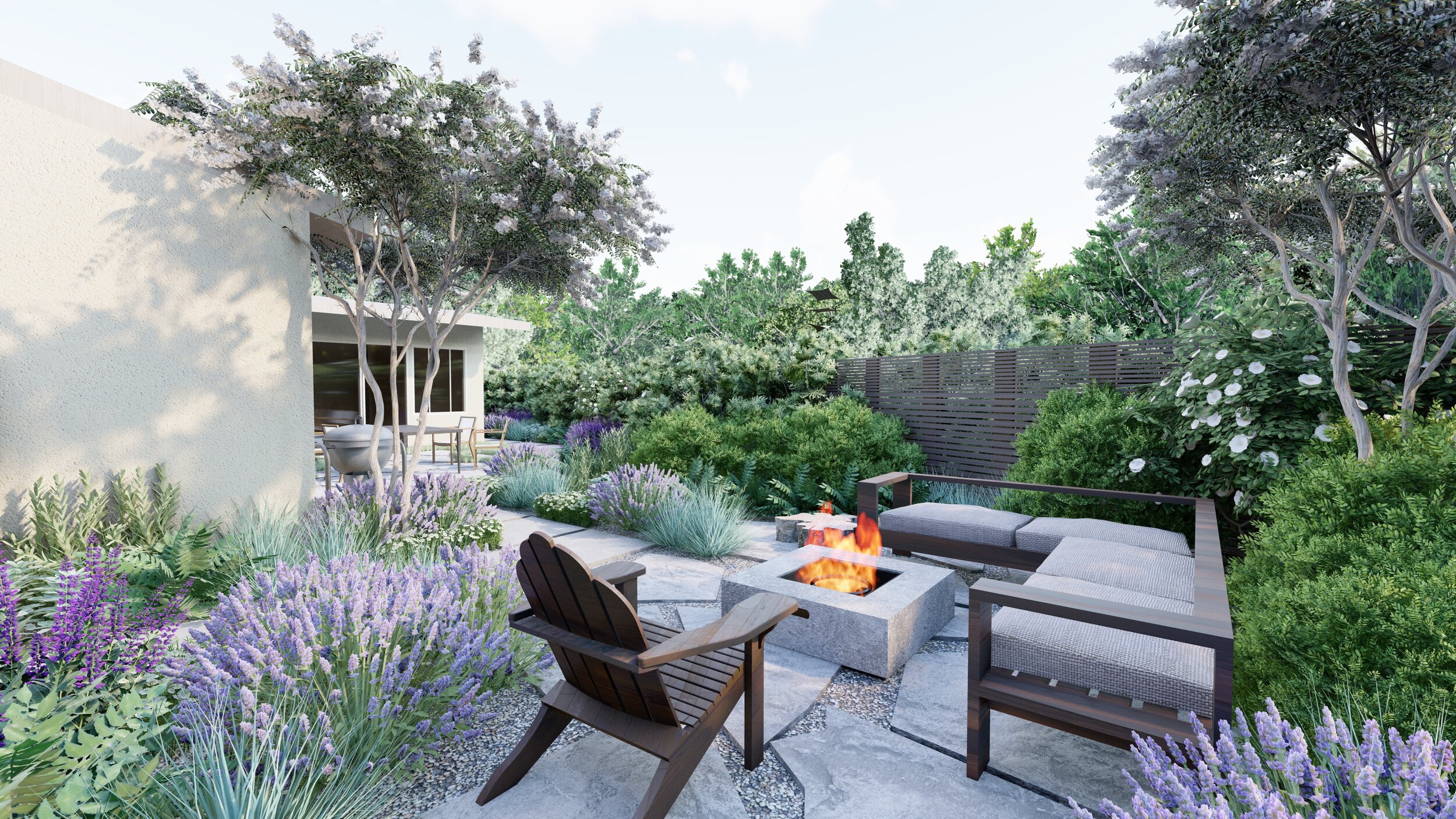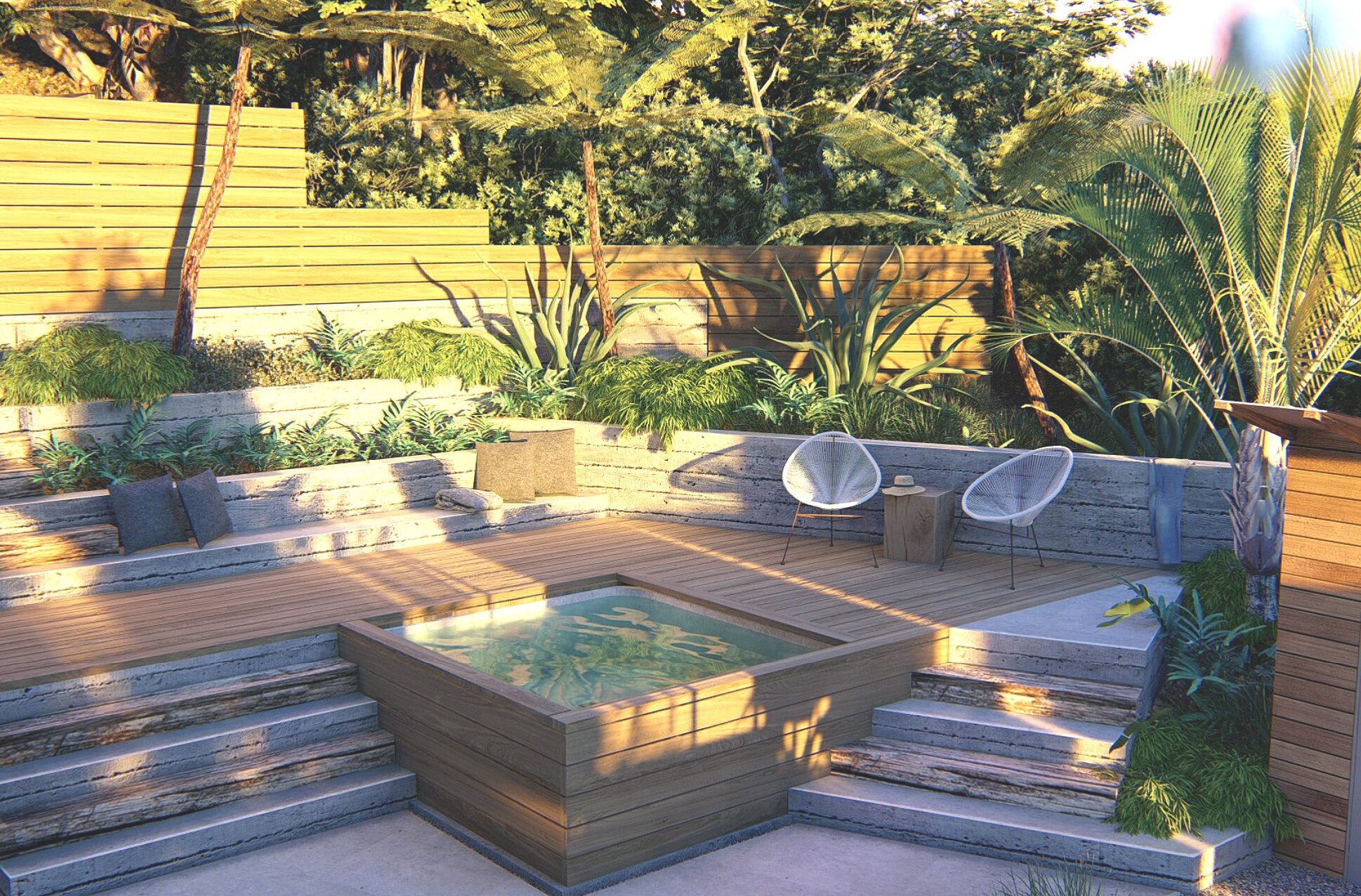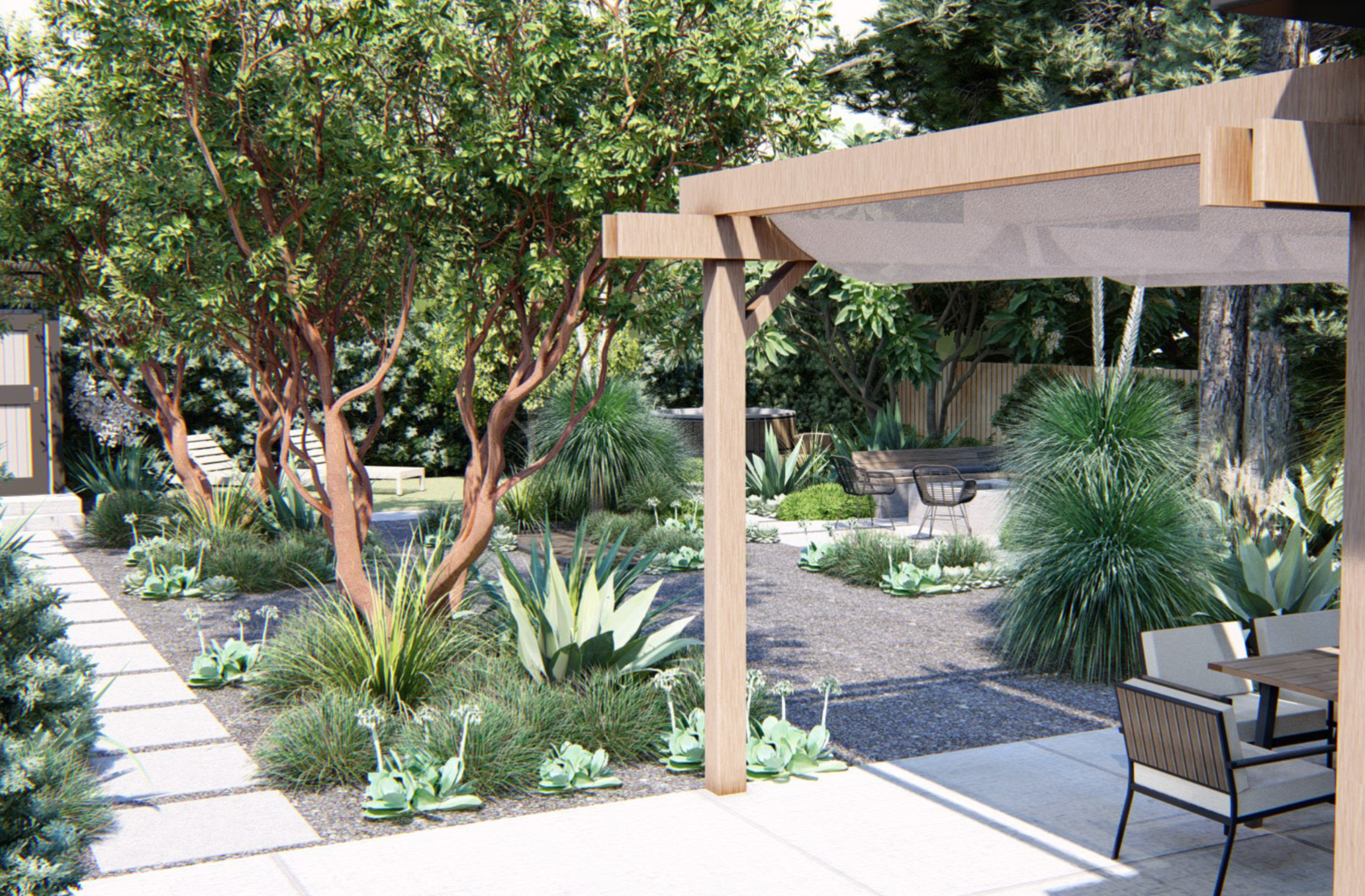For this blog post, we asked Yardzen’s designers to chose their twenty-five favorite Yardzen yards. It wasn’t an easy task—Yardzen has completed thousands of online landscape designs for homeowners throughout the United States. This is by no means an exhaustive list—we are proud of every design we create, so it was nearly impossible to choose just twenty five. So, let’s call this list a “glance” at some of Yardzen’s best work. See more in Yardzen Portfolio!
Inspired by what you see? Get started on your yard renovation today!
Small Yard for the Whole Family
Our designers transformed this small yard in the Bay Area to meet the needs of the whole two-legged and four-legged family. The covered patio creates the perfect setting for family dinners, while the grass provides a small play space for kids and pets. The fire pit and built-in bench are the parents’ favorite retreat for evenings after the family goes to bed. See more of this yard HERE.
Boho Hideaway in Seattle
Stepping into this backyard instantly transports you to a peaceful and relaxed state of mind. That’s thanks to the dense plantings of shade-loving plants, like Lady Ferns and Astilbe (the white, flowering plant dotted throughout), which create a woodsy, whimsical look. The swath of grasses in this small yard creates space for kids and dogs to play, while the gravel patio sets the scene for a relaxing evening around the fire pit. Learn more this project’s budget in our Guide to Landscaping Costs. See more of this yard HERE.
The Ultimate Southwestern Yard
This beautiful backyard in Dallas’s Highland Park transport you to the southwest with a mix of cactus, stone, woods, pea gravel, and warm whites. Learn more about the pricing for this backyard in our Guide to Landscaping Costs. Tap to scroll through the design. See more of this yard HERE.
Year-Round Outdoor Living in Winter Park, Florida
Moditerranean Getaway
This backyard is an entertainer’s dream. The built-in bar, complete with a grill, refrigerator, and ample counter space, creates the perfect setting for hosting friends and family. Several seating areas surround the bar, including a dining table and a vine-covered patio with a couch. Mediterranean plants, like lavender, agave, and olive trees, set the stage for this romantic, inviting backyard. The angularity of the plants, combined with cement pavers and gravel, adds a modern flair to this timeless, stunning yard. See more of this yard HERE.
Desert Oasis in Phoenix, Arizona
Connecticut Classic
This sloped backyard in Connecticut sets the scene for the ultimate summer vacation. Our designers used beautiful, rustic retaining walls to create a beautiful backyard entertaining space. With smart design engineering, we carved out distinct spaces to fulfill the homeowners’ priorities: a small pool, fire pit, and room for a grill. See more of this yard HERE.
Edible Yard for Entertaining in Portland
This large city backyard has space to do it all: grow vegetables, sit by the fire, relax under the shade of the pergola, and eat dinner on the deck, all surrounded by permeable, easy-to-maintain pea gravel and concrete pavers. The mix of cool-colored plants, which withstand summer heat and soak up winter rains, add a moditerranean feel to the space. (What is moditerranean? Learn more in our Guide to Landscaping Styles.)
Backyard Retreat in the City
This tiny backyard in San Francisco has SO much going for it! Our designers created the perfect city retreat by combining a built-in bench, cool-colored hardscaping, and climate-adapted plants, like lavender, grasses, flax lily, and olive trees. The outdoor dining table is perfect for those magically warm nights in the city by the bay.
Coastal Getaway in the Hamptons
Casual Elegance for a Traditional Home in Georgia
Xeriscaping for a Midcentury Modern
The owners of this mid-century home in Austin wanted their yard to reflect the style of their house. To stay true to the exterior design, we chose textural plants and arranged them in neat lines to mirror the architectural movement. Because water usage is a concern in western Texas, we selected plants like fescue, agave, and lavender, which are drought-tolerant, as well as low-maintenance. We created a walkway by edging square pavers with pea gravel—a fantastic, water-permeable solution for hardscape—and laid down more pea gravel beyond the plantings (learn more about gravel hardscaping).
Traditional Yard for an American Farmhouse
Social Front Yard in the Southwest
Tiered Yard in Austin
A multi-level yard featuring a mix of climate-adapted plants, easy-to-maintain hardscape, and cascading decks. The ideal spot to kick back with friends and enjoy a local brew. See more of this yard HERE.
Elegant Entertaining Space in Seattle
Boho Backyard
Wine Country Backyard
What was once an empty yard full of dirt and debris is transformed into a classically cool backyard in California’s wine country. Now, it’s the perfect space to enjoy the evening outside with a glass of cabernet and a slice of pizza, fresh from the wood-fired oven. The star of this backyard is the custom cooktop, including the pizza oven, a gas grill, and the Big Green Egg charcoal BBQ. Plantings include an Aspen tree and ornamental grasses, and for the patio, we included a large slab of poured concrete with linear joints that create the feel of large pavers.
Scottsdale Retreat
Modern Bohemian Backyard in Westchester
Relaxing Escape in the Bay Area
The busy owners of this Bay Area backyard wanted us to design a space for them where they could unplug and relax. Our designers incorporated design elements that encourage lounging, like a fire pit and ample seating areas. They also included plants with soothing fragrances, like lavender and sage—climate-adapted, easy-to-maintain plants that ensure this backyard always feels like a peaceful place.
Multi-Use Yard in Tempe, AZ
Space to Reconnect in the Pacific Northwest
This beautiful backyard, which sits adjacent to a canopy of evergreens, creates the ultimate outdoor space for year-round get togethers with friends and family. The fully covered patio creates a beautiful shelter from winter rains and summer sun and includes a built-in grill and cooktop, along with plenty of space for dining and entertaining. Beyond the covered patio, a built-in bench and poured concrete fire pit call for late evenings spent under the stars.
Brooklyn Backyard
Coastal Escape on Bainbridge Island
Bring the Resort Home in Belle Island, Florida
Modern Coastal Bungalow in Santa Monica
For this project in Santa Monica, CA, staff Horticulturalist, Zolene Quindoy, who holds a degree in Horticulture from UC Davis, designed a yard that meets all of the lawn replacement rebate requirements for the local municipality. The whole yard is permeable—pavers count as a permeable material as long as gravel surrounds them. Also, the plants, including Echeveria, Agave, Yarrow, and climate-adapted grasses, are all low-water.
The Social Front Yard in Southern California
Desert-Inspired Front Yard
This desert-inspired front yard in Austin would look beautiful in many of the regions we cover, from West Texas to Southern Nevada and California to the arid regions of the Pacific Northwest. A variety of low-water cactus and grasses blend beautifully with decomposed granite and rough-hewn boulders.
Craftsman with a Family Story
There is a touching story behind this newly built, modern craftsman home. The owner of this house inherited the land from his grandparents who loved to grow fruits and vegetables, and he wanted his new yard to honor their legacy, while still incorporating modern design elements to make the home feel contemporary. Throughout the yard, we made sure to keep all of the old-growth plants, like apple and cherry trees, and design around them. We added several new edibles, like grapevines along the driveway, citrus trees in the backyard, and several raised beds for vegetables and herbs. In the front, we added textural plants, like grasses and agaves, to make the yard feel fresh and modern.
A French Country Garden
This backyard transports you to the French countryside—fragrant lavender and lemon trees mingle with elegant trees that rustle in the wind. A long patch of grass beckons you to lay out a picnic blanket and enjoy some rosé on a Saturday afternoon, followed by dinner on the smooth, concrete porch and an evening spent by the fire, under the twinkling stars.
Contemporary Escape in the Woods of Woodinville, WA
Modern Rustic Backyard
This backyard is an extension of a newly-built, charcoal-colored, modern farmhouse. The homeowners wanted the backyard to reflect the mix of contemporary and country elements in their home, so our designers played with a mix of materials to complement the house. Throughout the yard, we incorporated woods—in the deck, in the furniture, and with the mulch that surrounds most of the yard—to play up the rustic features of the house. We also added more modern materials, like metal and concrete, and contemporary lines in the fire pit and pavers, to balance the yard and make it feel like a cohesive part of the exterior.
Spanish Bungalow
This front yard looks like it sprang straight from our Instagram feed—it captures so many elements of the latest design trends, including Spanish architecture, #organicmodern colors and textures, and always-trendy plants like agave and succulents. Although this yard looks and feels so contemporary, the simplicity makes it timeless.
The Sunset Magazine House
This house in Thousand Oaks is the epitome of Sunset’s west coast lifestyle. An expansive deck with built-in seating creates the ultimate setting for the best of outdoor living. The redwood deck includes a built-in hot tub and space for a farmhouse-style table. Flanking the sides of the raised patio are stucco planters filled with low-maintenance, climate-adapted plants, like Lomandra and Flax, both ornamental grass. Beyond the deck is a sprawling lawn for the family’s kids and dog. Our designer chose the Delta Bluegrass Native No-Mow sod, a drought-tolerant mix of fescues that also does well with shade (it’s our 2020 Plant of the Year!).
English Cottage Garden in the City
The English cottage garden, complete with pink flowers, abundant blooms, and traditional hedges, lands in sunny Southern California. The owners of this small backyard have big plans for a pool, a pergola, and an outdoor dining space, so our designers had to get creative with carving out individual spaces for all of those elements. Our favorite solution: a farmhouse table in the unused driveway! When you’re short on space or budget, we always recommend repurposing and thinking outside of the box.








